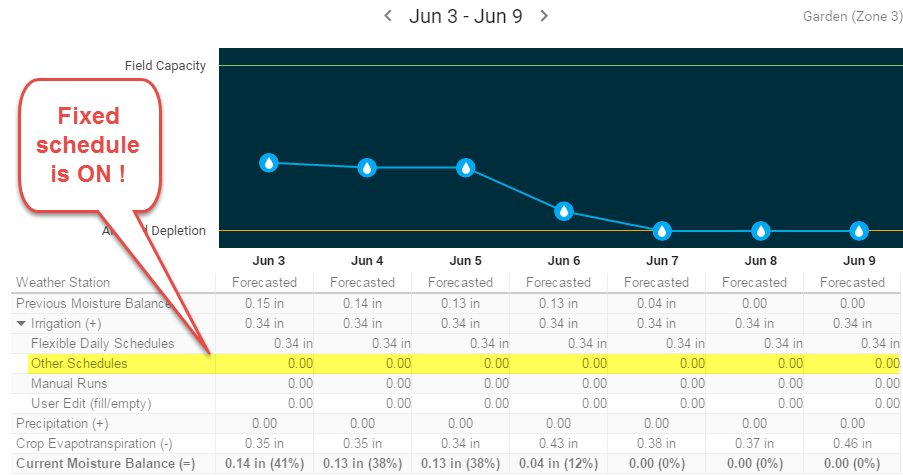Our temps in Phoenix are pushing 115-120F this weekend. I have a garden that had has been irrigating at 0.34in on a daily basis and it’s been doing fine. Since Rachio only makes daily decisions to water, and the evapotranspiration levels will soon exceed that pr, the system can’t keep up. It seems my only option is to make a change to something like my root depth to add more water per cycle. Would you guys agree? Any other ideas? I’m curious as to what the intention of the Rachio designers are for this type of situation, as well as the rest of you experts out there. Thanks!
yes root depth is an option. i like the idea to get the model as accurate as possible. If you know the root depth to be correct and the awc to be correct, then you might need a supplementary fixed schedule to run in the evening. At least until satain decides to stop tea bagging your area.
But if you are unsure about awc, I would add .05. If you are unsure about root depth, add an inch.
If things burn up and you have to replant, I would add a bunch of the miracle grow water save crystals to the solid because that will increase your awc by 200%.
At the end of the day you will have to play with it…adjust the parameter you feel the least confident is correct.
If these are annuals or veggies, you root depth should 4 inches, that’s all I can really suggest 
@plainsane First and foremost, thanks for picking up on my Dante reference and expanding on it so eloquently. 
Secondly, I really like your idea of adding the fixed schedule for the inferno season. I also like keeping the model accurate. With changing the root depth I was afraid I’d just be dumping extra water under the roots and it would evaporate anyway, with some perhaps marginal benefit to keeping the upper soil moist for a bit longer. By adding a fixed schedule midway between the flex watering, I could concentrate on the root zone. I thought it would be really cool to tweak the fixed schedule to see my moisture graph improve from the plots above. Unfortunately, the moisture graph isn’t picking up the fixed schedule watering, and looks exactly the same with or without the fixed schedule enabled. Am I missing something? Maybe this is the same GUI issue that I’ve read about elsewhere, where it won’t get picked up until the 1st watering cycle happens ? Thanks!
@JPedrego, I see in another thread that you also have a garden in Phoenix and are using Flex. I’m curious as to what your moisture graph and details look like for Jun 3-9th if you wouldn’t mind sharing ? Maybe I’m doing something wrong that’s causing me to bottom out if you’re not ?
I’ve been playing with this idea a bit because I have the same problem of the flex schedule not keeping up with Crop Evapotranspiration. The fixed watering is not reflected in the moisture graph until it is actually watered. In this way it is the same as manual runs.
In my case the flex schedule cant keep up because I am restricted to watering only 2 day’s per week.
The “bucket” never gets to 100% because Flex will never fill more than one bucket’s worth in a day but some or more than that bucket-full is used in the same day. It seems like in this scenario Flex should add duration or maybe another run later in the day to prevent run-off. In the phone app (but not the web app) the new introductory description of the Flexible Daily schedule actually says “Watering durations may change based on need.” This doesn’t seem to be the case.
No I’m not using Flex so I don’t think I have useful moisture graphs to share. I have a fixed schedule that was originally running every three days but I just switched it to every other day because of the scary temperatures that are setting in now. I was trying to find all the info needed so I could get a good flex schedule going since I know I’ll probably end up overwatering the garden out of fear if I do the math myself. Not confident that I have good values in the advanced settings yet so I’m not comfortable switching it to flex yet.
To elaborate, I think what this means is that, if enough time is allowed between the fixed schedule and the flex schedule, the fixed watering will be taken into account when the Flex recalculates the need for watering right before it runs. I think it needs an hour or two buffer to work.
@JPedrego Fair enough. I’d love to compare notes as you progress on your Flex daily setup. We’re in a bit of a unique situation trying to maintain a garden in 110-120F degree temperatures. Thanks for your response!
@rodmitch Ok, I see what you’re saying. I’ll take a look at the graphs again tomorrow morning, as my first fixed run will start tonight. I’ll feed back what I see to the forums. Thanks!
@franz Thanks. So would you categorize this as a ‘known limitation’ ? Assuming so I could see the complexity of adjusting the algorithms to watering increments shorter than 1-day, so I’m wondering if this would stay in the ‘known limitation’ category. Any chance that we’d expect a future rev. to handle this type of scenario ?
@azdavidr This will have to be in the known limitation category until we can really understand the problem and provide a solution. This is a tough one.

@franz Ok, that’s kind of what I expected given the nature of the issue. Having said that, there might be a seemingly straightforward way to ease the pain and help users along in the short term. I knew enough about this and the upcoming weather to go look at my moisture graphs. If I hadn’t, my garden may have suffered greatly. Maybe I stand a chance now by adding the fixed, late-day schedule that @plainsane recommended.
It seems that you should pretty easily be able to create a notification for someone when one of their zone’s ET levels exceed their PR, and the moisture graph flatlines. It would have been great for my system to tell me “Warning: Upcoming weather patterns predict that your current watering cycle will be insufficient for your vegetation type starting on {insert date}. See our Rachio support article {insert link} for more information.” The article could have an example like the one here, and suggested solutions such as adding the fixed watering schedule to help ‘fill the bucket’. The beauty is that it seems that all of the data is there, and those of us on the fringe would benefit greatly!
i might be wrong, but i think the main issue right now is that flex calculations and weather data are not real time streaming (i think some data is batched, some is not?).
they really need a cep engine driving this, but unless you are getting real time weather change events, its going to be impossible to solve this with a cep engine.
can you believe i found a woman stupid enough to wedlock such an inarticulate boner.
@plainsane @franz Agreed with respect to a fix to the algorithm, but with regards to an automated alert, I was thinking that the daily forecast is fine. In this example, the system would see the prediction next week for consecutive days where ET exceeds moisture and send me a heads-up. Am I missing something on that front ?
well, here is the issue. if they dont know the current temp at your house until 12:00 am, how are they supposed to know this is happening to your flowers, https://s-media-cache-ak0.pinimg.com/736x/7e/73/ce/7e73ce12717d376a95f0f88476d02a7f.jpg and kick off a schedule run.
so, now with prediction, you are entering the realm of machine learning. maybe something simple could be done looking at the predictions every night and see that this will happen, but its not like 10 lines of code, they will need to compute a trend in the data (trend passed solar indexes, past humidity) to run a regression for estimated future temperatures and plot that curve. im not telling anybody how to do it, they might have something sitting around, i dont know, but as a software engineer, im quite confident in its complexity.
@plainsane I read this article over the weekend, http://www.wired.com/2016/05/the-end-of-code/, and want our systems to be self learning in a few years 

i just interviewed with a company using scala and spark to build out a learning machine, i know very little about it, but they are willing to educate on the job so im hopeful…
that is a good article, there are a few ted talks worth watching, i think businesses will finally get what they want, solid software with monkeys at a keyboard saying yes or no to a series of classifications.
I’m not a software engineer, but I program occasionally as part of my job. You’d probably correctly identify it as one of those knows-enough-to-be-dangerous things. If the bottom row of the moisture table I uploaded, current moisture balance, were represented by an index of cmb<x:0>, and you cycled through i = 0 to x-1 and set cmb_alert = 1 if cmb(i)+cmb(i+1) == 0, then wouldn’t I get an alert ?
i = 0 (June 3)
i = 1 (June 4)
…
i = 6 (June 9)
cmb(0) = 0.14
cmb(1) = 0.13
cmb(2) = 0.13
cmb(3) = 0.04
cmb(4) = 0.00
cmb(5) = 0.00
cmb(6) = 0.00
cmb(4) + cmb(5) = 0.00 and so cmb_alert would get asserted and I’d be sent an alert.
I’m wincing as I send this as my software skills are elementary and I’m sure there are MUCH better ways of doing this! I’m trying to use this to get my train of thought along that the data is already there to give a heads-up. The solar index, humidity, etc. are already a part of the ET number I think, and I’m not sure that regressions are needed for something that’s just a heads-up rather than a schedule change? I’m just looking for the tool to essentially tell me ‘Hey, you may want to check out your moisture graphs in the next couple of days’. As it stands right now I have to remember to check the graphs regularly to be sure I don’t get in trouble. I was blown away as our temps when from the upper 80’s last week to upper 110’s this week.
Thanks for the constructive discussion and again for the suggestion to add the fixed schedule!
Now I remember why I don’t miss Arizona. I couldn’t handle the heat!






